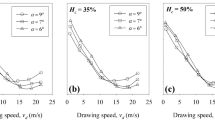Abstract
The ideal flow theory is used to determine the optimal die profile for the drawing and extrusion of sheets under the conditions of a plane strain. The solution is based on the theory of characteristics. In contrast to the available solutions based on the ideal flow theory, it is assumed that a portion of the die is prescribed. The solution is reduced to evaluating ordinary integrals. As an example, a die profile is found assuming that a portion of this profile is given and is a circular arc.




Similar content being viewed by others
REFERENCES
N. Zabaras, S. Ganapathysubramanian, and Q. Li, “A continuum sensitivity method for the design of multi-stage metal forming processes,” Int. J. Mech. Sci. 45, 325–358 (2003).
A. I. Oleinikov, S. N. Korobeinikov, and K. S. Bormotin, “Optimization of the type of finite element representation for simulation of the forming process of elasto-plastic panels,” Vychisl. Mekh. Splosh. Sred. 1 (2), 63–73 (2008).
C. J. Cawthorn, E. G. Loukaides, and J. M. Allwood, “Comparison of analytical models for sheet rolling,” Proc. Eng. 81, 2451–2456 (2014).
K. Chung and S. Alexandrov, “Ideal flow in plasticity,” Appl. Mech. Rev. 60, 316–335 (2007).
R. Hill, “Ideal forming operations for perfectly plastic solids,” J. Mech. Phys. Solids 15, 223–227 (1967).
S. E. Aleksandrov, “Planar steady-state ideal flows in plasticity theory,” Izv. Akad. Nauk, Mekh. Tverd. Tela, No. 2, 136–141 (2000).
O. Richmond and S. Alexandrov, “Nonsteady planar ideal plastic flow: general and special analytical solutions,” J. Mech. Phys. Solids 48, 1735–1759 (2000).
O. Richmond and M. L. Devenpeck, “A die profile for maximum efficiency in strip drawing,” in Proceedings of the 4th U. S. National Congress on Applied Mechanics, Ed. by R. M. Rosenberg (ASME, New York, 1962), Vol. 2, pp. 1053–1057.
O. Richmond, “Theory of streamlined dies for drawing and extrusion,” in Mechanics of the Solid State, Ed. by F. P. J. Rimrott and J. Schwaighofer (Univ. Toronto Press, Toronto, 1968), pp. 154–167.
M. L. Devenpeck and O. Richmond, “Strip–drawing experiments with a sigmoidal die profile,” ASME J. Eng. Ind. 87, 425–428 (1965).
O. Richmond and H. L. Morrison, “Streamlined wire drawing dies of minimum length,” J. Mech. Phys. Solids 15, 195–203 (1967).
R. Hill, The Mathematical Theory of Plasticity (Oxford, Oxford Univ. Press, 1998), Vol. 9.
S. Alexandrov, Y. Mustafa, and E. Lyamina, “Steady planar ideal flow of anisotropic materials,” Meccanica 51, 2235–2241 (2016).
ACKNOWLEDGMENTS
This work was supported by the Russian Science Foundation, project no. 16-49-02026.
Author information
Authors and Affiliations
Corresponding authors
Additional information
Translated by A. Muravnik
Rights and permissions
About this article
Cite this article
Lyamina, E.A., Novozhilova, O.V. Optimal Die Profile for the Plane Strain Drawing of Sheets. Math Models Comput Simul 11, 159–167 (2019). https://doi.org/10.1134/S2070048219020091
Received:
Published:
Issue Date:
DOI: https://doi.org/10.1134/S2070048219020091




